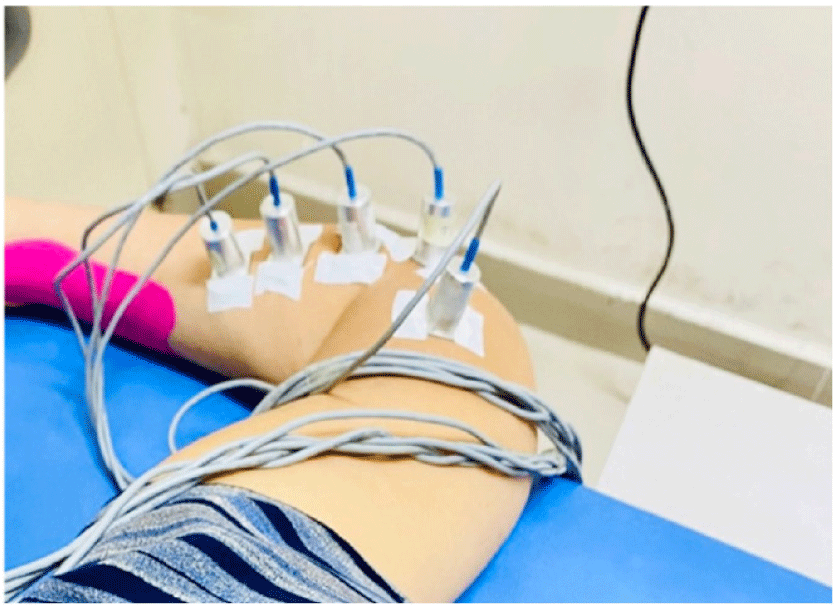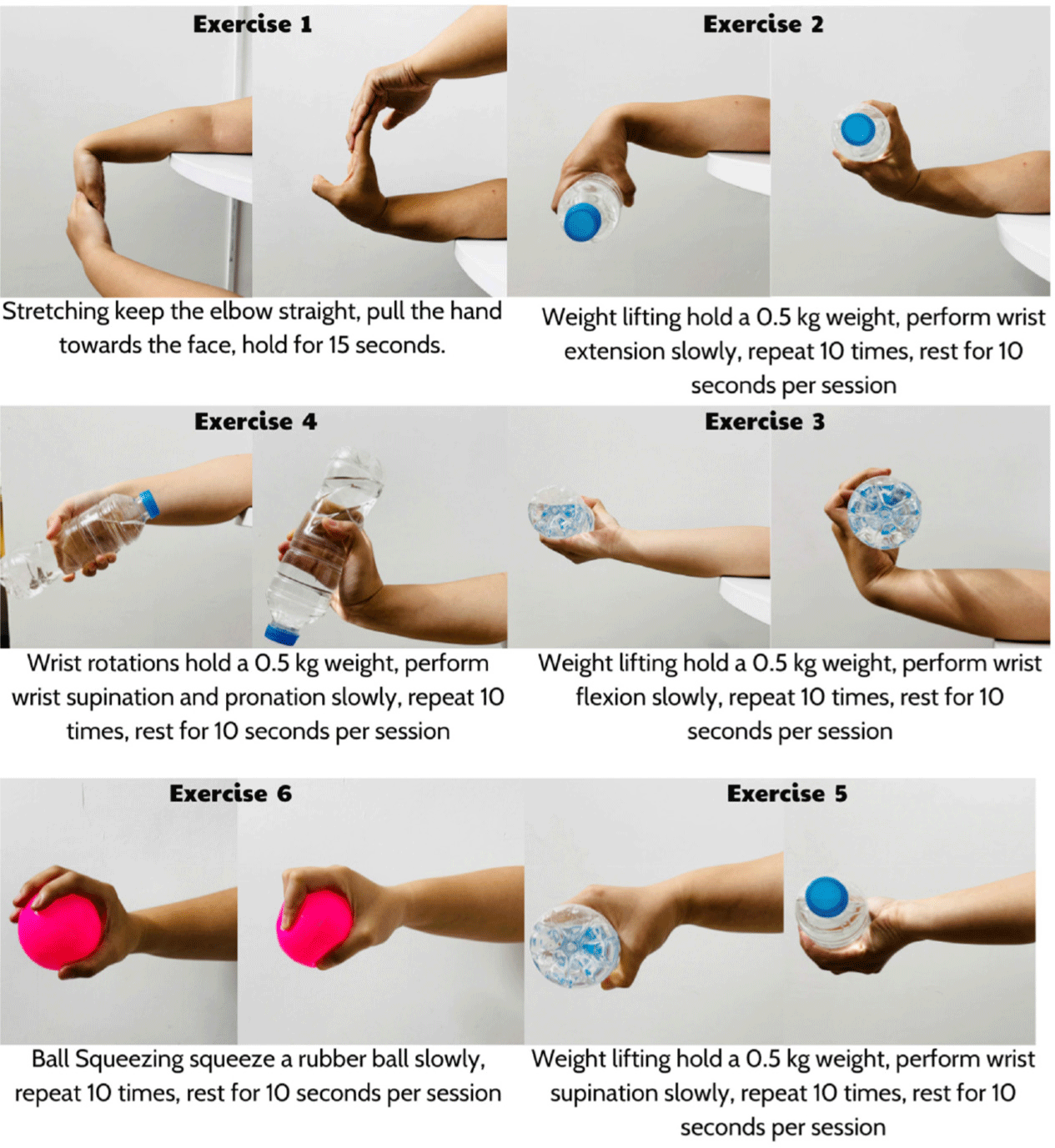1. INTRODUCTION
Lateral epicondylitis (LE) syndrome, also known as rower’s elbow, involves inflammation at the attachment site of the extensor carpi radialis brevis tendon, characterized by pain at the LE of the humerus [1]. Previous studies estimated that it affects 1–3% of adults annually. Additional research reported an overall incidence of LE syndrome by age and gender to be 3.4 per 1,000, with higher incidence rates among men and women aged 40–49 and 50–59, respectively [2,3]. The burden of LE syndrome continues to increase annually due to repeated microtrauma to the forearm’s extensor tendon [3]. It is a painful condition affecting the soft tissue on the lateral side of the elbow. The pain originates from or near the common extensor tendon attachment at the LE and can radiate into the forearm and the back of the wrist [4]. The primary cause is usually the overuse of the wrist and finger extensor muscles, particularly the extensor carpi radialis brevis, or strain resulting from opposing movements in the wrist’s supinated position [5]. According to Traditional Chinese Medicine (TCM), LE syndrome is described under syndromes like Bi and Tong. The cause is often attrivuted to external factors or a combination of internal and external factors causing qi and blood stasis in the elbow meridians, manifesting as pain, swelling, and limited movement. It is categorized into deficiency or excess syndromes. Common TCM patterns include wind-cold-damp, qi stagnation with blood stasis, or qi and blood deficiency with stasis. Treatment primarily involves Chinese herbal medicine and non-pharmacological methods such as acupressure, electroacupuncture, hydroacupuncture, catgut embedding, and laser acupuncture (LA) [6,7].
LA is a modern acupuncture technique that uses laser beams to stimulate acupuncture points, offering a less invasive alternative to traditional needles and demonstrating therapeutic effectiveness [8–11]. LA is non-invasive and may be a more feasible treatment option for both younger and older patients, as well as for those who have a fear of needles. One primary ethical consideration is the principle of non-maleficence, which emphasizes the importance of not causing harm to the patient. Non-invasive treatments like LA typically carry fewer risks of adverse effects such as infection, bleeding, or nerve damage which can be associated with invasive procedures such as manual acupuncture, corticosteroid injection, or surgery [12]. While some studies suggest that LA may benefit patients with tennis elbow, the evidence is still evolving. Ensuring that patients receive effective care is also an ethical obligation under the principle of beneficence—acting in the patient’s best interest [13].
Recent studies have shown that LA significantly improved pain in patients with LE [10]. Additionally, combining physical therapy for functional rehabilitation in treating LE syndrome treatment is essential for alleviating pain and restoring elbow joint function, as well as preventing long-term stiffness [11,14]. Elbow joint exercises, which are easy to perform, cost-effective, and applicable in the community, have shown high efficiency. In practice, many hospitals use LA and physical therapy to treat LE; however, its effectiveness has not been thoroughly evidence based.
Given the limitations in evaluating treatment effectiveness for pain relief and elbow range of motion (ROM) improvement, the combination of LA and physical therapy has not been thoroughly assessed for LE syndrome. Additionally, to enhance the effectiveness of combining TCM and modern medicine, we conducted the study: “Pain reduction and range of motion improvement of LA combined with physical therapy in patients with LE syndrome”.
2. MATERIALS AND METHOD
This pre-post pilot study aimed to evaluate the effectiveness of LA combined with physiotherapy in reducing pain and assessing potential side effects in patients with LE. This initial assessment served as a foundational step toward the development of future randomized controlled trials (RCTs) to provide more robust evidence on the efficacy and safety of this intervention. The research protocol was approved by the Institutional Review Board of the University of Medicine and Pharmacy in Ho Chi Minh City, ensuring compliance with ethical standards and following the TREND Statement Checklist (Transparent Reporting of Evaluations with Nonrandomized Designs) (Supplementary 1).
To enhance transparency and minimize bias, the study registered its pre-post pilot trial protocol before to data collection. ClinicalTrials.gov ID: NCT06535594 (https://clinicaltrials.gov/study/NCT06535594).
Because this was a pre-post pilot study, the sample size was set at 30 patients [15]. According to Julius (2005) [16], a sample size of approximately 12 participants per group is a common guideline for pilot studies, as it provides enough data to estimate variability and inform the design of larger studies. In addition, the effect size of LA in LE syndrome was 1.6, indicating a large effect [17,18]. Therefore, our choice of 30 participants fell within the recommended range for pilot studies and allowed for initial observations of treatment effects on pain (Visual Analog Scale [VAS]) and ROM.
A total of 30 patients diagnosed with LE were recruited from the outpatient department of the Physiotherapy and Rehabilitation Department at Le Van Thinh Hospital between February and September 2024. The diagnosis was based on a clinical examination (main symptoms: pain and tenderness at the LE or radial head lasting for more than a week, not caused by direct trauma, with at least one positive Cozen, Mill, or Maudsley test) and imaging tests.
-
Individuals between the ages of 19–65 years with LE in one arm and pain persisting for at least four weeks.
-
Individuals with tenderness limited to the elbow joint and surrounding area.
-
Individuals reporting pain during resisted extension of the middle finger and wrist.
-
Individuals with an average pain score of 40 mm or higher (0–100) mm on the VAS score in the week before the screening visit.
-
Individuals who volunteered to participate in the study and signed a consent form.
-
Patients who have undergone previous elbow surgery, have systemic diseases affecting joint mobility, or have received non-steroidal anti-inflammatory drugs, acupuncture, or physiotherapy for lateral epicondylitis within the last two weeks [15].
-
Patients requiring elbow joint replacement surgery.
-
Patients with psychiatric disorders.
-
Patients with other-related conditions besides LE, including elbow trauma, tuberculosis, or cancer.
-
Patients with unexplained skin abnormalities around the elbow joint, those currently using immunosuppressive drugs, or those undergoing prolonged corticosteroid treatment.
-
Patients with an acute illness requiring prior intervention.
-
Patients with a history of trauma, ligament damage, fracture, tumor, or previous elbow joint surgery.
Patients were treated by LA for 15 minutes per day, five times a week, continuously for four weeks [15,19]. The research used ACULASER Plus+ M320 devices (manufactured in Vietnam) to deliver pulsed mode waves at the wavelength of 780 nm, frequency of 60 Hz, wattage of 6 mW, and dose of 2–3 J for each acupuncture point (maximum 10 points and minimum 5 points) [15] (Table 1). Previous research and the World Association for Laser Therapy have recommended that LA at low frequency LA (such as 60 Hz in our research) has a therapeutic effect on musculoskeletal disease [20]. Before conducting the study, a traditional medicine specialist with more than 10 years of experience calibrated and checked the laser [9].
| Acupoint | Location | Effect | Biological mechanisms | Intensity |
|---|---|---|---|---|
| Ashi points | Painful areas around the elbow | Pain relief | Improving blood circulation, releasing endorphins, anti-inflammatory actions through the reduction of pro-inflammatory cytokine [21–23] | 2 J/cm2 |
| Quchi (LI11) | On the lateral aspect of the elbow, at the midpoint of the line connecting LU5 with the lateral epicondyle of the humerus. | Relief painful inflammation and weakness of the arm | 3 J/cm2 | |
| Shousanli (LI10) | On the posterolateral aspect of the forearm, on the line connecting LI5 with LI11, 2 B-cun inferior to the cubital crease. | Pain relief, removes obstructions from the channel | ||
| Zhouliao (LI12) | On the posterolateral aspect of the elbow, superior to the lateral epicondyle of the humerus, anterior to the lateral supraepi-condylar ridge. | Pain relief, removes obstructions from the channel | ||
| Chize (LU5) | On the anterior aspect of the elbow, at the cubital crease, in the depression lateral to the biceps brachii tendon. | Relaxes the sinews and eases pain |
The procedure was conducted in the treatment room and involved exposing the treatment area, thoroughly washing hands, identifying the acupuncture points (Table 1), disinfecting the skin at the acupuncture area, and securing the LASER channel at the acupuncture points, ensuring that the LASER beam was perpendicular to and close to the skin surface (Fig. 1).
The exercise therapy method involved six elbow joint exercises, conducted at the Department of physiotherapy and rehabilitation, Le Van Thinh Hospital. There were a total of six exercises (Fig. 2) for patients with tennis elbow [23–25]. Each exercise was performed three times a day, with each session involving five repetitions of the movement, over four weeks, gradually increasing weight until the movement was effective but below the pain threshold. Painful movements were avoided, and exercises causing pain or discomfort were discontinued following consultation from a physician.
The VAS is commonly used in clinical research to measure symptom intensity and has demonstrated reliability and validity for assessing acute and chronic pain assessment. The score is recorded by placing a handwritten mark on a 100 mm line with “no pain” on the left end and “worst possible pain” on the right. Patients mark a point on the line that corresponds to their pain level [26]. The VAS is also divided into three different levels of pain [27]:
From 0–39 indicates mild pain;
From 40–69 indicates moderate pain;
From 70–100 indicates severe pain.
To measure elbow flexion ROM, move the hand toward the shoulder with the forearm in supination. Flexion ends when resistance is felt, and further attempts result in shoulder flexion.
To measure elbow extension ROM, use a goniometer by positioning the fulcrum at the LE, aligning the stationary arm with the humerus, and aligning the moving arm with the forearm. Elbow extension typically ranges from 0° to 10° (or more in cases of hyperextension) and is not measured separately, as it serves as the starting point for flexion measurement.
With the individual seated and the elbow flexed at 90 degrees, pronate the forearm by rotating the distal radius until the palm faces the floor. Pronation ends when resistance causes to shoulder rotation and abduction.
Supinate the forearm by rotating the distal radius so the palm faces upward. Supination ends when resistance leads to shoulder rotation and adduction.
The active ROM of the elbow joint was measured using a goniometer. The study measured VAS pain scores and ROM scores at five time points: before treatment (T0/Tpre), at weekly intervals during treatment (T1, T2, T3), and after 4 weeks of treatment (T4/Tpost).
In the study, the patients were not informed about the aim of the study, and the VAS score and ROM were measured by different physiologists before and after the intervention to reduce bias. Additionally, we limited excessive interaction between researchers and participants throughout the study to minimize potential psychological influence during the intervention [28].
Adverse events were assessed at each visit based on vital signs and medical history. Common transient side effects such as hypotension [29], dizziness, headaches [30], and fatigue [31], skin redness, decreased vision, burna, hemorrhagea were recorded. All adverse events were documented in the case report form without referencing their association with interventions. In cases of severe adverse events, participants were required to temporarily stop the clinical trial [26].
Data were entered using Microsoft Office 365 Excel and Epidata, and analyzed using R-4.4.2. To maintain statistical test efficiency, the multiple imputation method was used to handle missing values. The the Shapiro-Wilk test was to assess the distribution of quantitative data. Data were expressed as mean±SD when normally distributed (analyzed using paired t-tests), or as median and interquartile range when not normally distributed (analyzed using Wilcoxon rank-sum test). Qualitative variables were described using frequency and percentage. Differences were considered statistically significant if p≤0.05. To measure effect size, Cohen’s d was applied for normally distributed, and Cliff’s Delta was used for ordinal or non-normally distributed data. The results were presented with 95% confidence intervals (CIs).
3. RESULTS
All 30 LE patients were screened for eligibility, and no patients met the exclusion criteria or were discontinued during the study (Fig. 3). The patients had a median age of 64 years (53.5–68), ranging from 39 to 77 years. The ratio of female to male patients was approximately equal and consistent across age groups. Intellectual occupations predominated (80%) with no statistically significant difference across age groups (p>0.05). Regarding pain characteristics, the median VAS score was 70 (60–70), with patients primarily in the moderate and severe pain categories at approximately equal rates. ROM was generally limited in flexion extension; however, forearm pronation-supination remained within the normal range (Table 2).
After four weeks of treatment, the VAS score showed a statistically significant reduction from T0, 70 (60–70) to T4, 30 (30–40) (p<0.001; Cohen’s d effect size for change in VAS score for LE=3.84; 95% [CI] 2.66–5.01; Cliff’s Delta effect size=–1; 95% [CI] –1––0.99). Throughout the treatment period, a statistically significant reduction in the VAS score was also observed starting from the first week (T1) (p<0.05) (Fig. 4A). Additionally, patients with severe pain tended to experience a greater reduction in pain compared to those with moderate pain, and there was no significant difference in VAS scores at T3 (p>0.05) (Fig. 4C). There was also no difference in VAS scores throughout the treatment period based on age (Fig. 4B) and occupational group (Fig. 4D).
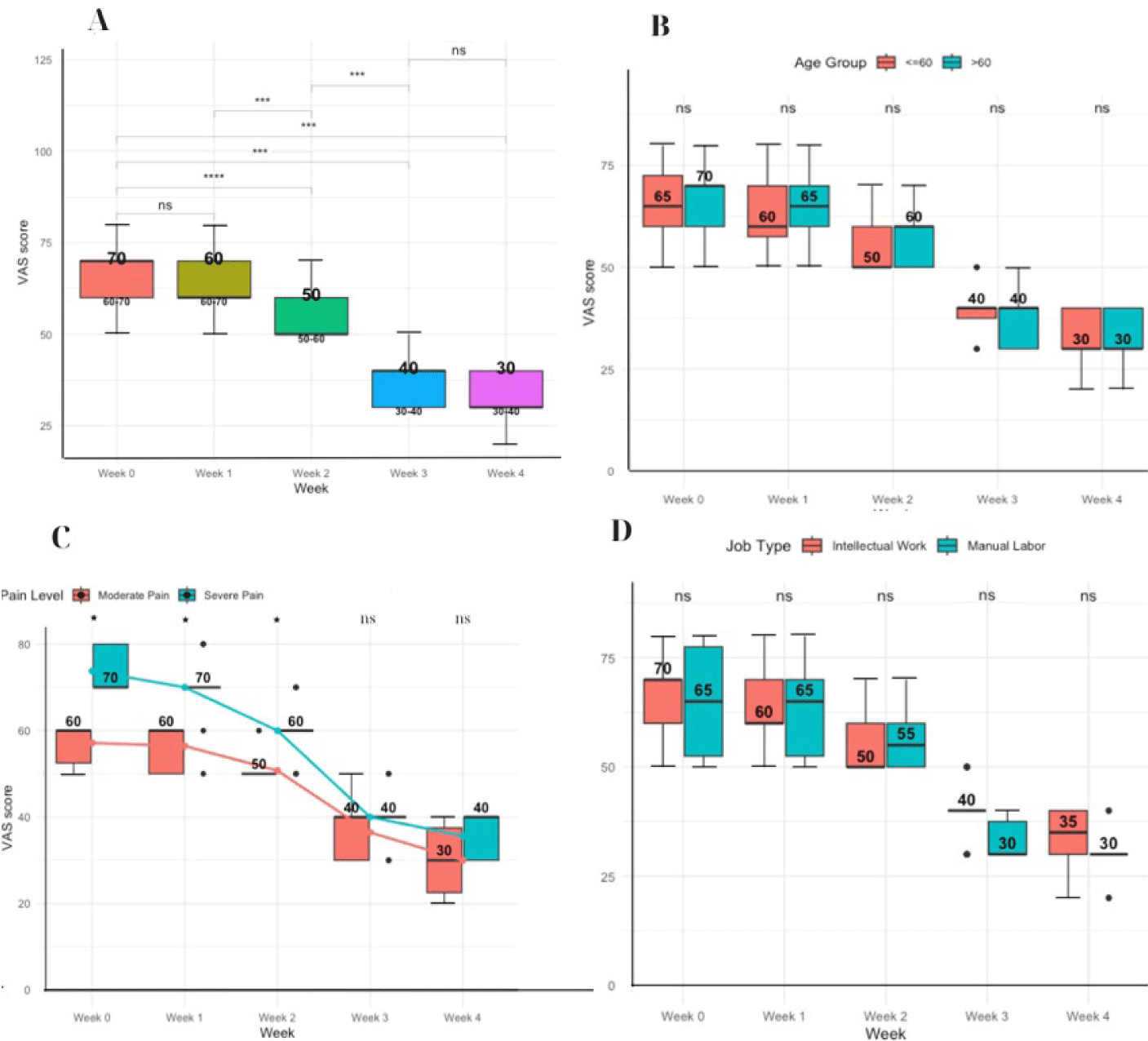
After 4 weeks, the extension ROM decreased from 8 (5.7–10) at T0 to 0 (0–1) at T4, with a statistically significant difference (p=0.002, Cohen’s d effect size for change in ROM of extension for LE=2.1; 95% [CI] 1.3–2.8; Cliff’s Delta effect size=–0.77; 95% [CI] –0.93––0.31). Throughout the study, the extension ROM improved each week starting from the T2 (Fig. 5).
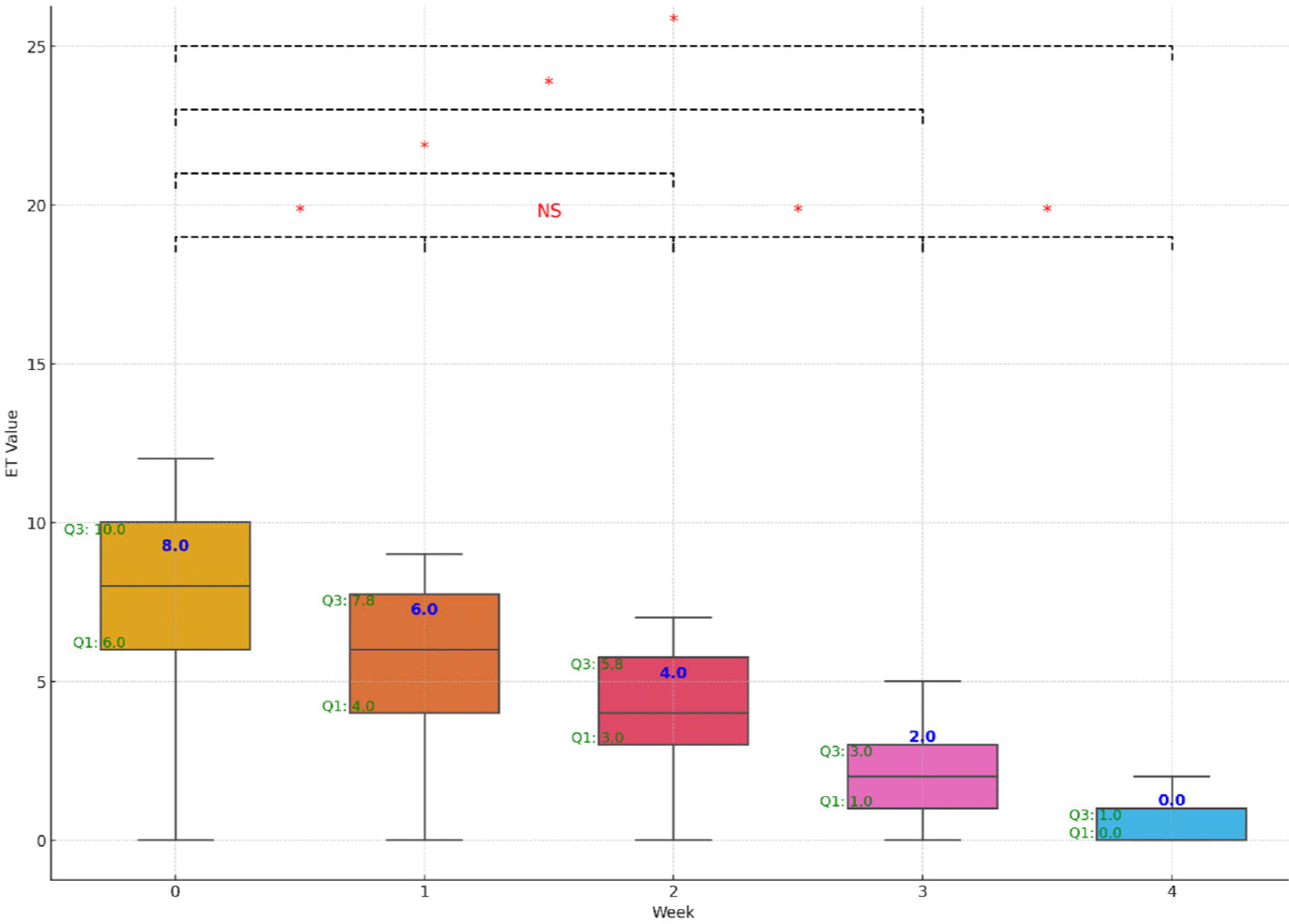
After 4 weeks, the flexion ROM improved from 138.5 (134.2–140) to 142 (140–144), with a statistically significant difference (p=0.002, Cohen’s d effect size for change in ROM of flextion for LE=–0.83; 95% [CI] –1.20––0.46; Cliff’s Delta effect size=0.46; 95% [CI] 0.16–0.67). The extension range gradually increased over time; however, this change was not statistically significant (p>0.05) (Fig. 6).
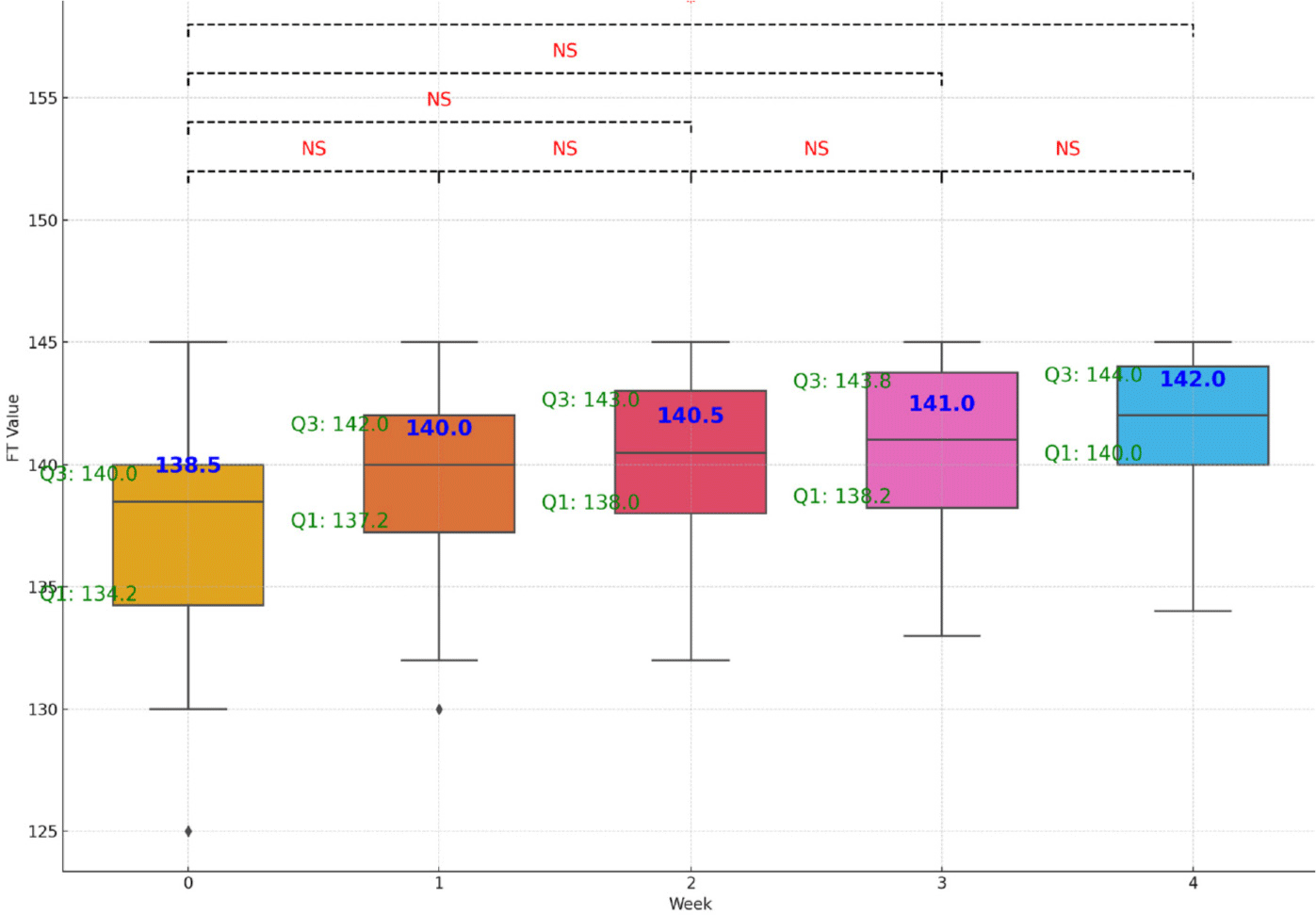
After 4 weeks, almost no statistically significant changes in supination and pronation angles were observed (p>0.05) (Table 3).
| Time point | Supination | Pronation | ||
|---|---|---|---|---|
| Median (IQR) | p-value | Median (IQR) | p-value | |
| Tpre | 79 (78.3–81) | 79.5 (78–81) | ||
| Tpost | 79 (78–81) | >0.05 | 79.5 (78–81) | >0.05 |
No side effects were observed when LA was administered during the study (Table 1–Supplementary 1).
4. DISCUSSION
This is the first study in Vietnam to preliminarily assess the potential effectiveness of combining physical therapy and LA in reducing pain and improving the ROM in LE patients. In a pre-post study conducted over four weeks of intervention, no patients withdrew during the study period. The results suggested that low-level laser therapy (LLLT) at acupuncture points around the elbow (Ashi, LI11, LI10, LI12, LU5) combined with physical therapy has the potential for pain relief and ROM improvement for patients with LE syndrome. Our findings are consistent with other studies on the effectiveness of pain reduction and ROM improvement [18,19,32,33]. However, there are a few differences from previous research. First, unlike the study by Kamel IEMA (2024) [32] on adolescent subjects, participants in our study had an average of 64 years (53.5–68) and included individuals still engaged in the workforce or sports, as well as elderly patients who are retired but continue to perform household chores. At Le Van Thinh Hospital, our patients were generally older but remained active in daily activities [34]. This approach may offer an advantage over traditional acupuncture or other invasive treatments for elderly patients who fear needles and have multiple comorbidities, as it involves only LA and physical therapy rather than NSAIDs, which were used in previous studies [32].
Secondly, although the study showed pain reduction and increased ROM after 4 weeks within a single group, this may be subject to placebo effects, making it challenging to assess the individual effectiveness of each method. However, we mitigated this by designing the study to limit excessive interaction between researchers and participants throughout the study period [35,36]. Additionally, the effectiveness in reducing the VAS score in our study was higher than the results of the placebo group in Acosta-Olivo CA’s study, which used normal saline injections. These findings suggest that the observed effects are due to the laser combined with physiotherapy [37]. Thus, we will include a control group to eliminate the placebo effect and assess the impact on patient function to confirm its effectiveness.
The laser dosage used was 2–3 J/cm² for acupoints, based on previous studies suggested by Stergioulas A [38,39]. Meta-analysis research indicated that a power output of 2J is suitable for acute pain points (ashi points), facilitating rapid recovery during inflammation and wound healing in the affected area [38]. Additionally, research by Longo L suggested that a power output of 3J is effective for nerve regeneration and improving blood circulation in painful joint areas [40]. Regarding the mechanism, the therapeutic effectiveness of LA through LLLT is supported by evidence demonstrating its impact on cellular and molecular mechanisms. These include activation of mitochondrial respiration, which leads to increased ATP production [41], release of nitric oxide, promoting vasodilation [42], a decrease in pro-inflammatory cytokines (e.g., TNF-α, IL-1β); and an increase in anti-inflammatory cytokines (e.g., IL-10), resulting in reduced inflammation and pain [43].
According to Traditional Medicine, tennis elbow is described within the frameworks of Bi Syndrome and Painful Obstruction Syndrome. Common causes often involve external pathogens or a combination of internal and external factors, leading to Qi and blood obstruction within the meridians around the elbow area. The connection between TCM meridians and musculoskeletal pain is notable, as studies show that exercises targeting meridians can effectively reduce pain and improve function. TCM holds that meridians are channels through which vital energy (Qi) flows, and exercises aimed at these pathways can enhance both physical and emotional well-being [44]. This represents a new approach to managing tennis elbow in the future, aiming to limit invasive procedures.
This study has some limitations. First, while our research focused solely on Vietnamese subjects, factors such as lifestyle, occupation, healthcare systems, and cultural attitudes may differ from those in other countries. However, studies on the effectiveness of low-power laser therapy have been conducted across various continents, including Europe [39], and Asia [17,18] with different lifestyle, cultural, and physical activity contexts, suggesting potential broader applicability in other regions in future research.
Second, due to ethical considerations and resource limitations, our study followed patients for only four weeks and did not include inflammatory markers. However, prior studies have assessed the biological effects of laser therapy on tendon repair and collagen formation [45], and have shown improvement with extended treatment durations of over eight weeks [17,43]. Moving forward, we plan to conduct longer-term studies with larger sample sizes, pending approval from the ethics committee.
Finally, the cost of LA devices is higher than that of traditional acupuncture and requires specialized training for practitioners. However, since these devices are manufactured in Vietnam, a developing country, and LA training is included in the Traditional Medicine Doctor program, in addition to being less expensive than methods such as corticosteroid injections or surgery, LA has the potential for widespread use in clinics in the future.
5. CONCLUSION
Low-intensity LA combined with physical exercise is a safe, non-invasive approach with the potential to improve acute pain and ROM in elderly patients in Vietnam with high pain levels. However, to establish it as a first-line option, further studies are needed to strengthen clinical evidence. Additionally, the group with higher pain intensity showed greater pain reduction compared to the moderate-pain group.

